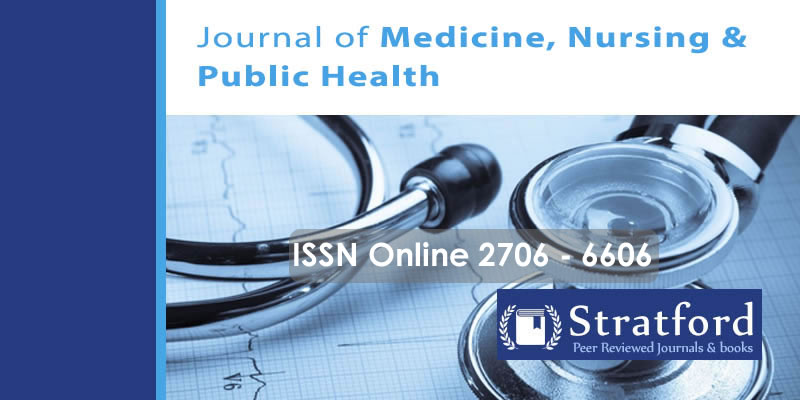Factors Influencing Adherence to Anti-Tuberculosis Treatment among Patients Attending Tuberculosis Clinics in Migori County, Kenya
DOI:
https://doi.org/10.53819/81018102t301014Abstract
Tuberculosis (TB), a disease caused by Mycobacterium tuberculosis, affected 10 million people and claimed the lives of 1.4 million people worldwide in 2018. Poor anti-TB treatment adherence has a number of negative consequences, including increased disease transmission. The incidence rate of tuberculosis in Nyatike sub-county is 209 per 100,000 people, compared to 155 in Migori County. As a result, the primary goal of the study was to identify factors that influence anti-TB treatment adherence among tuberculosis patients attending anti-tuberculosis clinics in Migori County, Kenya. The study employed an analytical cross-sectional study design, with the target population consisting of adult active TB patients (n=) on anti-TB treatment and health care providers (n=) involved in TB Comprehensive care clinic services. Questionnaires, focus group discussions, and key informant interviews were used to collect data, which was then analyzed using chi square and logistic regression techniques. The following factors were found to be associated with patient adherence in the study: HIV co-infection (OR=1.152, 95% CI; 0.408,3.691; p=0.029), in which HIV positive patients were 1.152 more adherent than HIV negative participants; using other non-TB drugs (OR=0.418; P= 0.008, 95% CI; 0.157, 1.109), with pill burden being a barrier for adherence to ant-TB treatment; and lack of money to meet Adherence was also found to be influenced by knowledge (OR: 2.856; 95% CI: 1.282, 6.365), P= 0.01). Anti-TB treatment adherence was found to be associated with HIV co-infection, taking other drugs alongside anti-TB patients, and financial constraints. The study's implication is that various factors influence patient adherence to anti-tuberculosis treatment.
Keywords: Adherence to Anti-Tuberculosis Treatment, Patients, Tuberculosis, Clinics, Migori County
References
Aibana, O., Dauria, E., Kiriazova, T., Makarenko, O., Bachmaha, M., Rybak, N., ... & Murray, M. B. (2020). Patients’ perspectives of tuberculosis treatment challenges and barriers to treatment adherence in Ukraine: a qualitative study. BMJ open, 10(1), e032027.
Amuha, M. G., Kutyabami, P., Kitutu, F. E., Odoi-Adome, R., & Kalyango, J. N. (2009). Non adherence to anti-TB drugs among TB/HIV co-infected patients in Mbarara Hospital Uganda: prevalence and associated factors. African health sciences, 9(2).
Boru, C. G., Shimels, T., & Bilal, A. I. (2017). Factors contributing to non-adherence with treatment among TB patients in Sodo Woreda, Gurage Zone, Southern Ethiopia: A qualitative study. Journal of infection and public health, 10(5), 527-533.
Du Vaure, C. B., Dechartres, A., Battin, C., Ravaud, P., & Boutron, I. (2016). Exclusion of patients with concomitant chronic conditions in ongoing randomised controlled trials targeting 10 common chronic conditions and registered at ClinicalTrials. gov: a systematic review of registration details. BMJ open, 6(9).
Kulkarni, P., Akarte, S., Mankeshwar, R., Bhawalkar, J., Banerjee, A., & Kulkarni, A. (2013). Non-adherence of new pulmonary tuberculosis patients to anti-tuberculosis treatment. Annals of medical and health sciences research, 3(1), 67–74. doi:10.4103/2141-9248.109507
Lei, X., Huang, K., Liu, Q., Jie, Y. F., & Tang, S. L. (2016). Is tuberculosis patients’ adherent to prescribed treatments in China? Results of a prospective cohort study. Infectious diseases of poverty, 5, 38. doi:10.1186/s40249-016-0134-9
Mekonnen, H. S., & Azagew, A. W. (2018). Non-adherence to anti-tuberculosis treatment, reasons and associated factors among TB patients attending at Gondar town health centers, Northwest Ethiopia. BMC research notes, 11(1), 691. doi:10.1186/s13104-018-3789-4
Muture, B. N., Keraka, M. N., Kimuu, P. K., Kabiru, E. W., Ombeka, V. O., & Oguya, F. (2011). Factors associated with default from treatment among tuberculosis patients in Nairobi province, Kenya: a case control study. BMC public health, 11, 696. doi:10.1186/1471-2458-11-696 Off, P. L., & Home, P. (2000). Essential Medicines and Health Products Information Portal
Samandari, T. (2011). Risk factors for non-adherence and loss to follow-up in a three-year clinical trial in Botswana. PloS one, 6(4), e18435.
Woimo, T. T., Yimer, W. K., Bati, T., & Gesesew, H. A. (2017). The prevalence and factors associated for anti-tuberculosis treatment non-adherence among pulmonary tuberculosis patients in public health care facilities in South Ethiopia: a cross-sectional study. BMC public health, 17(1), 269. doi:10.1186/s12889-017-4188-9
Zegeye, A., Dessie, G., Wagnew, F., Gebrie, A., Islam, S., Tesfaye, B., & Kiross, D. (2019). Prevalence and determinants of anti-tuberculosis treatment non-adherence in Ethiopia: A systematic review and meta-analysis. PloS one, 14(1), e0210422. doi: 10.1371/journal.pone.0210422.


